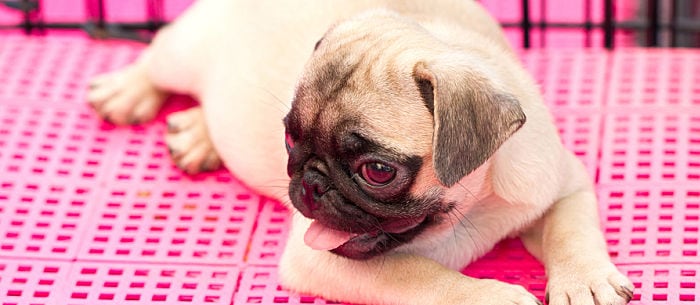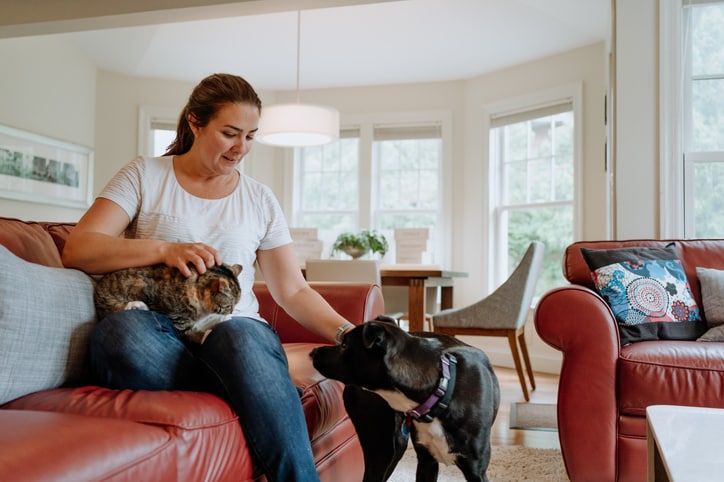Your dog is acting strangely, and you’ve noticed some spots on the floor. It could mean you have a dog in heat. What do you need to do about it? What can you expect?
What Does Being “In Heat” Mean?
When you have a female dog in heat, it means that she is, or is about to become, sexually receptive to male dogs, according to Dr. Norm Stillman, the founder of Court Street Animal Hospital in Plymouth, Massachusetts. She is advertising that she is able to conceive. Only female dogs go into heat, and it’s only during heat that they can become pregnant.
Signs That Your Dog is in Heat
Dr. Stillman says that the signs of a dog in heat are unmistakable and include the following:
- She will exhibit behavioral changes such as becoming more affectionate with you and paying more attention to male dogs.
- She will get her period. Yup, dogs get this too!
- She may attempt to mount other dogs or allow herself to be mounted.
- And, if you’re still questioning matters, you can check under the hood — her vulva will swell to up to four times its normal size.
Age, Frequency and Length of Heats
The age when heats begin for a dog is variable. They can be as young as six months and as old as 14 months. Dr. Stillman says it often correlates to the dog’s size, adding, “Smaller dogs are more likely to go into heat earlier.”
Dogs are typically in heat for about two to four weeks. Most females will go into heat twice a year, approximately every six months. Certain breeds, like the basenji and the Rhodesian ridgeback, only go into heat once a year. You will know that the heat is starting to taper off when heat behaviors lessen and the dog’s discharge turns from red blood to clear fluid. Female dogs will typically stop having heats when they are 9 or 10 years old.
Keep the Boys Away
It is crucial to keep a dog in heat away from male dogs if you want to prevent pregnancy. “Males are very inventive and will climb fences or try to enter your house. They will follow a scent trail across the neighborhood,” warns Dr. Stillman. A female dog in heat will give out a specific scent only detectable by other dogs, so don’t be surprised to find several male dog at your door! When walking your dog in heat, make sure she is securely leashed and close to you at all times.
Get Some Doggie Undies
She will bleed everywhere, so Dr. Stillman suggests purchasing some doggie hot pants or diapers, and then tucking a regular human maxi pad inside. Such dog panties are machine washable and will help keep your house and furnishings clean.
Keep Her Groomed
She may need to be groomed while she’s in heat, with a particular focus on the fur around her private parts, so that bloody discharge doesn’t dry in her fur.
Consider Spaying Your Dog
Spaying is a surgical procedure that prevents a female dog from reproducing. Dr. Stillman advises any owners that don’t intend to use their dogs for breeding to spay their dogs, as “pregnancy causes a lot of wear and tear on a dog, uses up a lot of their resources and is expensive for owners — and the risk of complications is high.”
He goes on to say if your dog does become pregnant, you will need to find homes for up to 12 puppies. Spayed female dogs show lower incidence of breast, ovarian and cervical cancers, and typically live longer.
Laura Richards is a Boston-based freelance writer and the mother of four boys including a set of identical twins. She is also mom to three rescue pets: Scarlett, a 7-year-old beagle, and Edith and Ollie, 15-year-old identical twin black cats. She has written for numerous parenting publications and is the president of On Point Communications.
* This article is for general informational purposes only. It is not intended nor implied to be providing medical advice and is not a substitute for such advice. The reader should always consult a health care provider concerning any medical condition or treatment plan. Neither Care.com nor the author assumes any responsibility or liability with respect to use of any information contained herein.



